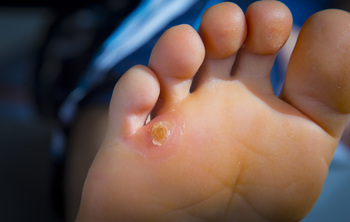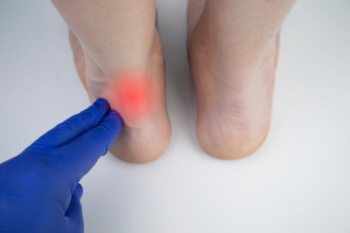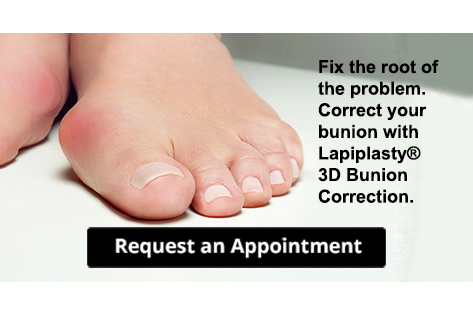Connect With Us
Blog
Items filtered by date: October 2024
Definitions and Causes of Corns and Calluses

Corns and calluses are thickened areas of skin that develop as a protective response to friction and pressure. Corns typically form on the toes and are small, often painful growths with a hard center. Calluses are larger and usually appear on the soles of the feet or palms, serving as a broader protective barrier. The primary causes of corns and calluses include poorly fitting footwear, repetitive activities, and abnormal foot mechanics. Wearing ill-fitting shoes can create pressure points that lead to corn formation, while continuous friction from walking or standing may result in calluses. Conditions such as bunions or hammertoes can worsen these issues. While corns and calluses serve a protective function, they can become uncomfortable and may require attention to prevent further complications. If you have pain from either corns or calluses, it is suggested that you contact a podiatrist who can offer you effective relief solutions.
If you have any concerns regarding your feet and ankles, contact one of our podiatrists of Advanced Foot & Ankle. Our doctors will treat your foot and ankle needs.
Corns: What Are They? and How Do You Get Rid of Them?
Corns can be described as areas of the skin that have thickened to the point of becoming painful or irritating. They are often layers and layers of the skin that have become dry and rough, and are normally smaller than calluses.
Ways to Prevent Corns
There are many ways to get rid of painful corns such as wearing:
- Well-fitting socks
- Comfortable shoes that are not tight around your foot
- Shoes that offer support
Treating Corns
Treatment of corns involves removing the dead skin that has built up in the specific area of the foot. Consult with Our doctors to determine the best treatment option for your case of corns.
If you have any questions please feel free to contact our offices located in Newburg and Taylorsville, KY . We offer the newest diagnostic and treatment technologies for all your foot and ankle needs.
Facts About Sesamoiditis

Sesamoiditis is an inflammation of the sesamoid bones, which are small bones embedded within the tendons of the big toe. This condition typically arises due to repetitive stress or overuse, often experienced by athletes or individuals who engage in activities that involve pushing off the toes, such as running or ballet. Common symptoms include pain in the ball of the foot, swelling, and tenderness, particularly during movement or when pressure is applied. Affected individuals may also experience difficulty bearing weight or limited range of motion in the big toe. Factors contributing to sesamoiditis include wearing improper footwear, high-impact sports, and foot deformities like high arches or flat feet. Sesamoiditis can cause pain and discomfort, and it may become difficult to complete daily activities. If you have developed this condition, it is suggested that you are under the care of a podiatrist who can offer you appropriate treatment solutions.
Sesamoiditis is an unpleasant foot condition characterized by pain in the balls of the feet. If you think you’re struggling with sesamoiditis, contact one of our podiatrists of Advanced Foot & Ankle. Our doctors will treat your condition thoroughly and effectively.
Sesamoiditis
Sesamoiditis is a condition of the foot that affects the ball of the foot. It is more common in younger people than it is in older people. It can also occur with people who have begun a new exercise program, since their bodies are adjusting to the new physical regimen. Pain may also be caused by the inflammation of tendons surrounding the bones. It is important to seek treatment in its early stages because if you ignore the pain, this condition can lead to more serious problems such as severe irritation and bone fractures.
Causes of Sesamoiditis
- Sudden increase in activity
- Increase in physically strenuous movement without a proper warm up or build up
- Foot structure: those who have smaller, bonier feet or those with a high arch may be more susceptible
Treatment for sesamoiditis is non-invasive and simple. Doctors may recommend a strict rest period where the patient forgoes most physical activity. This will help give the patient time to heal their feet through limited activity. For serious cases, it is best to speak with your doctor to determine a treatment option that will help your specific needs.
If you have any questions please feel free to contact our offices located in Newburg and Taylorsville, KY . We offer the newest diagnostic and treatment technologies for all your foot and ankle needs.
Painful Bunions? There's a New Treatment Option in Lapiplasty®
Causes of Toenail Abnormalities

Toenail abnormalities can indicate underlying health issues and can include clubbed nails, fungal infections, trauma, and ingrown toenails. Clubbed nails appear enlarged and curved, often linked to respiratory or cardiovascular conditions. Trauma to the toenail can result from injuries, leading to discoloration, pain, or even loss of the nail. Fungal infections thrive in warm, moist environments and can cause thickening, discoloration, and brittleness of the nail. Ingrown toenails occur when the nail grows into the surrounding skin, causing pain, swelling, and potential infection. Additionally, nail-patella syndrome, a genetic disorder, may appear with abnormal toenails alongside other skeletal issues. If you notice changes in your toenails, it is strongly suggested that you consult a podiatrist who can determine the cause and offer effective treatment solutions.
Toe pain can disrupt your daily activities. If you have any concerns, contact one of our podiatrists of Advanced Foot & Ankle. Our doctors can provide the care you need to keep you pain-free and on your feet.
What Causes Toe Pain?
Most severe toe pain is caused due to a sports injury, trauma from dropping something heavy on the toe, or bumping into something rigid. Other problems can develop over time for various reasons.
Toe pain can be caused by one or more ailments. The most common include:
- Trauma
- Sports injury
- Wearing shoes that are too tight
- Arthritis
- Gout
- Corns and calluses
- Hammertoe
- Bunions
- Blisters
- Ingrown toenails
- Sprains
- Fractures (broken bones)
- Dislocations
When to See a Podiatrist
- Severe pain
- Persistent pain that lasts more than a week
- Signs of infection
- Continued swelling
- Pain that prevents walking
Diagnosis
In many cases the cause of toe pain is obvious, but in others, a podiatrist may want to use more advanced methods to determine the problem. These can range from simple visual inspections and sensation tests to X-rays and MRI scans. Prior medical history, family medical history, and any recent physical traumatic events will all be taken into consideration for a proper diagnosis.
Treatment
Treatments for toe pain and injuries vary and may include shoe inserts, padding, taping, medicines, injections, and in some cases, surgery. If you believe that you have broken a toe, please see a podiatrist as soon as possible.
If you have any questions please feel free to contact our offices located in Newburg and Taylorsville, KY . We offer the newest diagnostic tools and technology to treat your foot and ankle needs.
Causes and Risk Factors of Achilles Tendon Injuries

Achilles tendon injuries are relatively common, particularly among athletes and active individuals. The Achilles tendon, which connects the calf muscles to the heel bone, is prone to strains and tears due to its role in walking, running, and jumping. Common causes of injury include sudden increases in physical activity, such as jumping or sprinting, and inadequate warm-up exercises. Risk factors for Achilles tendon injuries include age, as the tendon weakens with time, and conditions like obesity, which places extra stress on the tendon. Individuals with poor flexibility or muscle imbalances are also at a higher risk. Wearing inappropriate footwear or having a history of previous tendon injuries can further increase susceptibility. An Achilles tendon injury can cause extreme pain and discomfort. If you have sustained this type of injury, it is suggested that you consult a podiatrist who can effectively treat this condition.
Achilles tendon injuries need immediate attention to avoid future complications. If you have any concerns, contact one of our podiatrists of Advanced Foot & Ankle. Our doctors can provide the care you need to keep you pain-free and on your feet.
What Is the Achilles Tendon?
The Achilles tendon is a tendon that connects the lower leg muscles and calf to the heel of the foot. It is the strongest tendon in the human body and is essential for making movement possible. Because this tendon is such an integral part of the body, any injuries to it can create immense difficulties and should immediately be presented to a doctor.
What Are the Symptoms of an Achilles Tendon Injury?
There are various types of injuries that can affect the Achilles tendon. The two most common injuries are Achilles tendinitis and ruptures of the tendon.
Achilles Tendinitis Symptoms
- Inflammation
- Dull to severe pain
- Increased blood flow to the tendon
- Thickening of the tendon
Rupture Symptoms
- Extreme pain and swelling in the foot
- Total immobility
Treatment and Prevention
Achilles tendon injuries are diagnosed by a thorough physical evaluation, which can include an MRI. Treatment involves rest, physical therapy, and in some cases, surgery. However, various preventative measures can be taken to avoid these injuries, such as:
- Thorough stretching of the tendon before and after exercise
- Strengthening exercises like calf raises, squats, leg curls, leg extensions, leg raises, lunges, and leg presses
If you have any questions please feel free to contact our offices located in Newburg and Taylorsville, KY . We offer the newest diagnostic tools and technology to treat your foot and ankle needs.
Is Gout Dangerous?

Gout is a form of arthritis triggered by a buildup of uric acid in the bloodstream, which crystallizes in the joints, leading to sudden and severe pain, redness, warmth, and difficulty moving the affected area. This condition often targets the big toe joint but can impact other joints in the feet as well. Although gout flare-ups may subside on their own over time, the condition can become chronic, with increasing frequency of flare-ups and potential permanent joint damage. Managing gout effectively involves early diagnosis, appropriate treatment, and lifestyle adjustments. To alleviate symptoms and prevent future episodes, it is important to seek professional help. A podiatrist can provide expert advice, diagnosis, and a tailored treatment plan to manage gout and protect your foot health. For comprehensive care and guidance on managing gout, it is suggested you schedule an appointment with a podiatrist.
Gout is a foot condition that requires certain treatment and care. If you are seeking treatment, contact one of our podiatrists from Advanced Foot & Ankle. Our doctors will treat your foot and ankle needs.
What Is Gout?
Gout is a type of arthritis caused by a buildup of uric acid in the bloodstream. It often develops in the foot, especially the big toe area, although it can manifest in other parts of the body as well. Gout can make walking and standing very painful and is especially common in diabetics and the obese.
People typically get gout because of a poor diet. Genetic predisposition is also a factor. The children of parents who have had gout frequently have a chance of developing it themselves.
Gout can easily be identified by redness and inflammation of the big toe and the surrounding areas of the foot. Other symptoms include extreme fatigue, joint pain, and running high fevers. Sometimes corticosteroid drugs can be prescribed to treat gout, but the best way to combat this disease is to get more exercise and eat a better diet.
If you have any questions please feel free to contact our offices located in Newburg and Taylorsville, KY . We offer the newest diagnostic and treatment technologies for all your foot and ankle needs.

